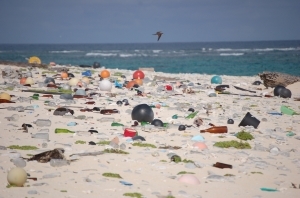Nearly 500 miles northwest of Hawaii, there's a tiny rectangular island in the middle of Pacific.
Though it's only 26 acres -- the size of roughly 20 football fields -- Tern Island is a life-saving rest stop for millions of birds, green sea turtles and endangered Hawaiian monk seals. They've learned over thousands of years that this island is a safe, clean refuge -- even a place to sometimes raise their young.

Plastic pollution covers a beach on Laysan Island, near Tern Island, in the Northwestern Hawaiian Islands, where it washed ashore. Photo by Susan White, U.S. Fish and Wildlife Service.
Lately, though, Tern Island has become a garbage dump.
Or, more precisely, it's an unwitting collection point for plastic bottles, caps, bags and other litter that's part of the swirling, larger-than-Texas mass of trash called the Pacific Garbage Patch.
Plastic pollution kills or injures thousands of seabirds, seals, dolphins, turtles and other animals every year. Some get tangled in it and drown, others are strangled by it, and still more starve after eating it because they've fooled their body into thinking they've consumed something nutritious. That says nothing about the toxicity of this plastic, which can move up the food chain to bigger fish and marine mammals.
It's a depressing fate for these animals, and it'll only get worse if we continue to litter our oceans with grocery bags, soda bottles, straws and other bits of mindlessly discarded trash.
There is some good news, though: The Environmental Protection Agency just took a historic first step toward classifying Tern Island as a Superfund site. This initial step-research at the island, with a focus on toxicity threats posed to wildlife in the area, may eventually lead to a spot in Superfund, the federal program designed to identify and clean up the country's most polluted areas.
The action comes after a petition earlier this year by the Center for Biological Diversity. We've launched a new campaign to address plastic pollution. There are billions of pounds of plastics swirling around in our oceans. In the Los Angeles area alone, 10 metric tons of plastic fragments are carried into the Pacific Ocean every day.
Much of that trash rides the currents, and finds its way to the vast and undulating Pacific Garbage Patch, which spills over to places like the Northwest Hawaiian Islands -- a 1,200-mile chain of scattered island and atolls that are home to more than 7,000 marine species, 25 percent of which are found nowhere else on Earth.
That includes the Tern Island, a place once home to a Naval Air Station and a U.S. Coast Guard station, but now primarily inhabited by birds, turtles and seals.
It may be hundreds of miles from human civilization, but it's not remote enough to escape the litter of our modern lives. We have a responsibility to protect this island -- and, in fact, all ocean habitats -- from the scourge of plastic pollution. Here's hoping we act fast enough to make a difference.